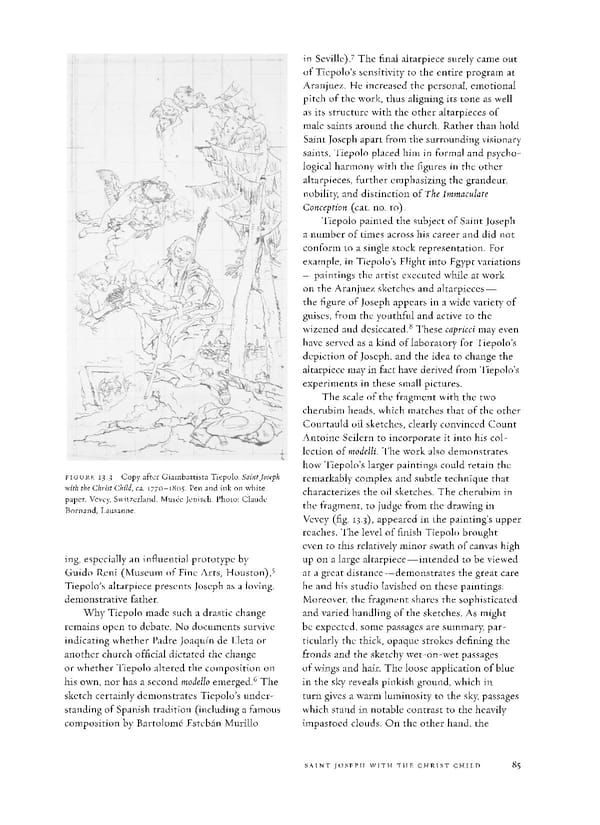7 in Seville). The final altarpiece surely came out of Tiepolo's sensitivity to the entire program at Aranjuez. He increased the personal, emotional pitch of the work, thus aligning its tone as well as its structure with the other altarpieces of male saints around the church. Rather than hold Saint Joseph apart from the surrounding visionary saints, Tiepolo placed him in formal and psycho- logical harmony with the figures in the other altarpieces, further emphasizing the grandeur, nobility, and distinction of The Immaculate Conception (cat. no. 10). Tiepolo painted the subject of Saint Joseph a number of times across his career and did not conform to a single stock representation. For example, in Tiepolo's Flight into Egypt variations —paintings the artist executed while at work on the Aranjuez sketches and altarpieces — the figure of Joseph appears in a wide variety of guises, from the youthful and active to the 8 wizened and desiccated. These capricci may even have served as a kind of laboratory for Tiepolo's depiction of Joseph, and the idea to change the altarpiece may in fact have derived from Tiepolo's experiments in these small pictures. The scale of the fragment with the two cherubim heads, which matches that of the other Courtauld oil sketches, clearly convinced Count Antoine Seilern to incorporate it into his col- lection of modelli. The work also demonstrates how Tiepolo's larger paintings could retain the FIGURE 13.3 Copy after Giambattista Tiepolo. Saint Joseph remarkably complex and subtle technique that with the Christ Child, ca. 1770-180$. Pen and ink on white characterizes the oil sketches. The cherubim in paper. Vevey, Switzerland, Musee Jenisch. Photo: Claude the fragment, to judge from the drawing in Bornand, Lausanne. Vevey (fig. 13.3), appeared in the painting's upper reaches. The level of finish Tiepolo brought even to this relatively minor swath of canvas high ing, especially an influential prototype by up on a large altarpiece—intended to be viewed Guido Reni (Museum of Fine Arts, Houston),5 at a great distance—demonstrates the great care Tiepolo's altarpiece presents Joseph as a loving, he and his studio lavished on these paintings. demonstrative father. Moreover, the fragment shares the sophisticated Why Tiepolo made such a drastic change and varied handling of the sketches. As might remains open to debate. No documents survive be expected, some passages are summary, par- indicating whether Padre Joaqum de Eleta or ticularly the thick, opaque strokes defining the another church official dictated the change fronds and the sketchy wet-on-wet passages or whether Tiepolo altered the composition on of wings and hair. The loose application of blue his own, nor has a second modello emerged.6 The in the sky reveals pinkish ground, which in sketch certainly demonstrates Tiepolo's under- turn gives a warm luminosity to the sky, passages standing of Spanish tradition (including a famous which stand in notable contrast to the heavily composition by Bartolome Esteban Murillo impastoed clouds. On the other hand, the SAINT JOSEPH WITH THE CHRIST CHILD 85
 Giambattista Tiepolo: Fifteen Oil Sketches Page 85 Page 87
Giambattista Tiepolo: Fifteen Oil Sketches Page 85 Page 87